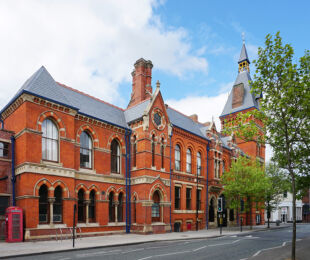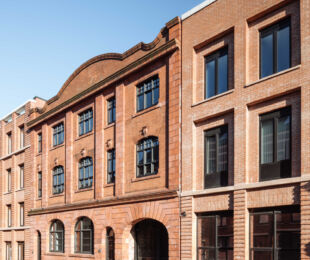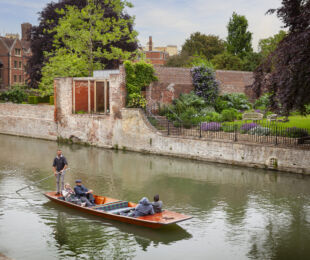
Staffordshire Blue Clay bricks provide a distinctive and idiosyncratic facade for The Interlock, a five-storey mixed-use building designed by architect Bureau de Change for developer HGG London. Its location, on Riding House Street in London’s Fitzrovia, is characterised by a rich variety of architectural styles, from John Nash’s neoclassical All Souls church at its western end, through nineteenth-century terraces to post-war commercial buildings. The street’s piecemeal aesthetic is unified, however, by the predominance of brickwork, which even provides the street surface in places. The Interlock develops this tradition and responds to the proportions of the neighbouring nineteenth-century terrace, recasting its facade to create a building of uncertain heritage – “one that is simultaneously historic and contemporary, familiar yet foreign”, according to the architect.
Rather than adopting the standard dimensions of London brick, however, a range of 44 unusually-shaped, and seemingly unstackable clay blocks was developed. “We were interested in taking these very traditional proportions and in some way subverting it – like a puzzle box that seems familiar and reveals a hidden complexity that increases the more you interact with it”, says Bureau de Change director Katerina Dionysopoulou.
The street elevation is composed to form patterns that arise, in part, from the interactions between material and structure. The bricks appear to lap up against the glazing, swelling and bowing between floors, and others are inset, like a frame, to mark the building edge. The effect, for passers-by, is of the bricks appearing to morph and twist like mechanical cogs. By modelling the facade in 3D, each facet was individually adjusted to meet structural and fabrication requirements without diluting the design integrity of the surface.
Staffordshire Blue Clay bricks were specified to contrast with the dominant red bricks in the vicinity. The marl clay was set into 14 hand-crafted steel moulds and fired so the oxidation created a matt blue finish, and following firing, the 14 ‘parent’ bricks were divided to form the 30 ‘offspring’. Construction of the 5,000-block elevation took more than three months, with the fabrication team using 188 full-scale printed templates with the number, type and position of each brick. “We worked iteratively with the manufacturer, adapting and reviewing the bricks in three dimensions. We were walking the line of what would be technically possible, but through this process, found a point that was both buildable and produced the richness and movement we were trying to achieve”, says Bureau de Change co-director Billy Mavropoulos.
The building contains a street-level cafe, a basement gallery, and three residential units above. The rear of the building is set out as a series of stacked ‘boxes’, with the deepest floor plan at the bottom and the smallest at the top. Within the stepped form are deep light wells and skylights that allow daylight into the centre and edges of the plan, with internal patios on the lower floors and light wells above. The flats include terrazzo bathrooms, stone worktops, sprayed timber kitchens and oak floors. The cafe is white-walled, with heavy-set mullions halved and extruded to form ribbons that curve and fold across the ceiling, like ornamental plasterwork.






